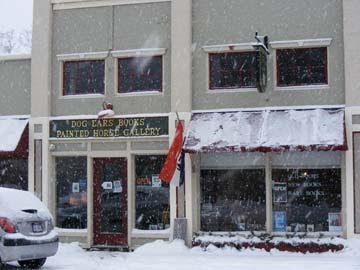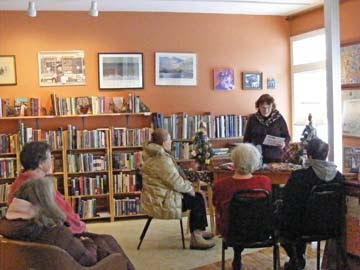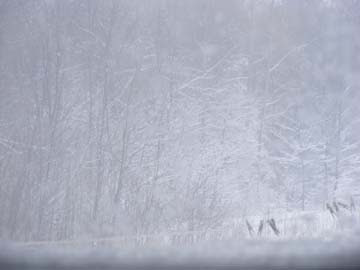
Okay, I admit it: I neither stayed up nor got up to see the lunar eclipse this morning. When I looked out the window last night at 9 p.m., the sky was clear, the moon was full, and I thought what a perfect night it would be for the eclipse—for other people. A few years back, returning from a visit to friends at Walloon Lake, we drove south along the east side of Grand Traverse Bay accompanied by a lunar eclipse and a comet. I was almost afraid to look in the rear-view mirror, because if we’d seen Northern Lights that night, too, why go on living? How could there be more after a night like that?

Why? Because life always has more to offer, and right now, in mine, books are so exciting that it’s hard for me to sit still in my reading chair! I want to rush to share the wonders! First, I’m nearing the end of Julie Altrocchi’s 1940 novel,
Wolves Against the Moon, with a setting that ranges from Quebec and the Great Slave Lake to Mackinac Island, through the Michigan territory, the Indiana dune country and Checagou, and down the rivers leading to the Mississippi and Baton Rouge and New Orleans. The story begins in 1794 and ends in 1835. The main character, Joseph Bailly (real man, part of history), was French by birth and a British citizen by virtue of his family’s immigration to Canada. He traded furs throughout the Michigan territory and eventually settled his family in northern Indiana, under the mistaken impression that the land he chose for their home was in Michigan. I could go on but am reining myself in, because there’s too much to go into this morning with this novel.


Then, before I’ve reached the end of
Wolves Against the Moon, Monday’s mail brought me the long-awaited advance reader’s copy of Loreen Niewenhuis’s
A 1,000-Mile Walk on the Beach: One Woman’s Trek on the Perimeter of Lake Michigan. Do you think I could set this new book calmly aside and finish my novel first? No, indeed! I had to open it and read the introduction and then, like a lake trout, I was hooked! Loreen begins her walk in Chicago! Oh, wonderful coincidence! Chicago, the Calumet River, Gary, the railroads and steel mills, and on to the beautiful beaches and the Indiana dunes—this was the Lake Michigan of my childhood. It was also—log cabins of Checagou, the Little Calumet River, Marquette Spring, the Sauk Trail, Parc aux Vaches--the Lake Michigame of the Indians and fur traders many years before, in the time period covered by Altrocchi’s novel.

In my own life, for years after the expressways came, I could still escape them on trips from Kalamazoo to visit my family in Illinois by taking the back roads of the old Sauk Trail through small towns and countryside. That’s all over--now it’s subdivisions, shopping malls and multilane, stop-and-go traffic--but I have traveled this part of the Midwest all my life, earlier and later following the lakeshore north to what has been my home for many years. The country of Altrocchi’s novel, later my life’s landscape, is the country of Niewenhuis’s true-life adventure, too, so I will have the thrilling satisfaction of exploring twice in one month, with two different authors, two centuries apart, land and water that I know and love, learning from both books aspects of the beloved geography that I never knew before.

Do you wonder I am so excited?!
Meanwhile, at the bookstore, thank heaven for the little tabletop trees and their brightly colored ornaments brought in by Marjorie Farrell this holiday season because cheap, nonworking electric holiday lights have been my Grinch issue of 2010. Shoddy consumer goods isn’t a very festive topic, but those strings of lights from last year that wouldn’t work at all this year, plus the one string that worked for a few days and then died a gradual death, bothered me a lot.
“Can’t you just get more at the hardware store? They don’t cost very much, do they?”

Yes, the hardware has plenty, and no, they are cheap as dirt, and that’s a big part of the problem. Like disposable everything-else, they are made to be thrown away—but as McDonough & Braungart in
Cradle to Cradle, Paul Hawken in
The Ecology of Commerce and many others have noted, there is no “away.” It all goes into someone’s backyard. Now here's a new book on what we can do about the problems.
Everyday Justice: The Global Impact of Our Daily Choices, by Julie Clawson (IVP Books, 2009, $16)
Julie Clawson addresses exactly the question asked by one of my commenters recently, i.e., “What can I do—me—in my own life to change the world?” Clawson’s perspective is Christian, and her theme is that while not everyone can be a designer, we are all called upon to live justly and that justice demands we take responsibility for the consequences of our choices, however remote. On the other hand, she doesn’t want her readers to freak out and say, “It’s too hard! It’s too complicated! I can’t change my whole life completely!” So chapter by chapter, Clawson takes on justice issues involved in coffee, chocolate, cars, food, clothes, waste and debt. A little scenario begins each chapter, followed by hard and difficult truths (including child slavery overseas, and you don’t want to be part of that, do you?), but then she winds up with concrete suggestions for changes we can make in our everyday lives, some of them very small.
Electric and electronic waste, e-waste, my
bête noir of the season, isn’t just strings of dead lights. It’s dead cell phones, dead computers, dead microwave ovens, dead television sets and, soon, dead e-readers.
Theoretically, recycling electronic waste should be a money saver for corporations. Reusing heavy metals like lead is far easier and cheaper than mining them. But the infrastructure for safe recycling isn’t widespread in the United States, and the government generally subsidizes virgin-mining operations [my emphasis added]. Until structures are in place and systems change, these expensive and precious, yet toxic, metals will continue to be thrown away—or else sold overseas to countries eager for easy and cheap access to expensive metals.
Nearly 80 percent of electronic waste that is recycled [sic] in the United States ends up being sold overseas. While the idea of recycling this metal is good on one level..., problems arise because of the lack of environmental laws in many of those countries. As electronic waste gets recycled (smelted down) in these countries, the toxic byproducts of that process spread into the surrounding environment.
Investigation into one rural area of Peru where metal recycling had contaminated soil in farmers’ fields found 99 percent of children suffered from lead poisoning. That’s just the metals, too. What about the plastics encasing those metals and the gases released when those plastics are heated?
In light (yes!) of all this, I’ve regretfully decided to boycott the product in question until some environmentally responsible company offers strings of holiday lights with a good, solid 10-year guarantee, price fully refundable. I don’t expect to get them for a dollar a string but am willing to pay for a durable, quality product.
Please note that
I am not criticizing or condemning anyone who has working strings of holiday lights, even if they were bought new this season! Each of us makes different choices, and my life is no more environmentally blameless than anyone else’s. This is just one place I’ve decided to dig in
my heels and say, “Enough’s enough!”
Something else strikes me here: Judaism always stressed justice and mending the broken world (a figure of speech Clawson uses early in her book), while the just society was a major concern of the ancient Greek (pagan) philosophers. “Christianity” is not one religion but many, with great differences across the spectrum, but if Clawson’s arguments can reach that large, diverse population, then more power to her. Our world needs to have this message coming in on as many channels as possible.


















































